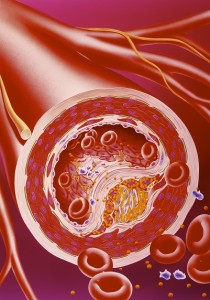 Dyslipidemia refers to lipid imbalance more often defined as elevated triglyceride and small dense LDL-cholesterol levels and decreased HDL-cholesterol levels in the blood. Apart from being an independent risk factor of coronary artery disease, dyslipidemia is closely associated with diabetes mellitus. Results from over fifty years of clinical data obtained from “one of the most important epidemiological studies in the annals of American medicine” [1] the Framingham Heart Study showed that elevated total cholesterol levels independently increases the risk of coronary heart disease in subjects with or without diabetes. In addition, the study showed that 19% of men and 17% of women with diabetes have significantly higher triglyceride levels compared to those without diabetes (9% of men and 8% of women). [2]
Dyslipidemia refers to lipid imbalance more often defined as elevated triglyceride and small dense LDL-cholesterol levels and decreased HDL-cholesterol levels in the blood. Apart from being an independent risk factor of coronary artery disease, dyslipidemia is closely associated with diabetes mellitus. Results from over fifty years of clinical data obtained from “one of the most important epidemiological studies in the annals of American medicine” [1] the Framingham Heart Study showed that elevated total cholesterol levels independently increases the risk of coronary heart disease in subjects with or without diabetes. In addition, the study showed that 19% of men and 17% of women with diabetes have significantly higher triglyceride levels compared to those without diabetes (9% of men and 8% of women). [2]
While a broad range of therapy options are available for treating dyslipidemia, effective treatment of this condition relies on a successful multifactorial approach. This may include individualized treatment options through lifestyle modification in the presence of metabolic syndrome and variable lipid profiles. [3]
Tocotrienol: Triglyceride and cholesterol-lowering properties
Tocotrienol helps maintain cardiovascular and metabolic health by promoting lipid (fat) balance through triglyceride and LDL cholesterol reduction by up to 25%. [4] In in vitro studies, animal models and a clinical trial, scientists from Davos Life Science showed that tocotrienol reduced the production and transport of triglycerides in the body, thereby reducing triglyceride levels by 28%. [5]
Targeting the HMG-CoA Reductase Pathway
As early as 1993, scientists at Bristol-Myer Squibb found that tocotrienols, particularly the gamma and delta isoforms, could inhibit cholesterol synthesis through the post- transcriptional suppression of HMG-CoA reductase, the key protein essential for cholesterol production. [6] Cholesterol reduction is also achieved through the increased breakdown besides reduced translation of reductase protein to active proteins necessary for HMG-CoA activity. Presently, statins remain the primary pharmacologic standard for the treatment of dyslipidemia. While effective, statins at higher doses come with unfavourable side effects such as abnormal liver function tests, nerve dysfunction and muscle disease as it blocks the melanovate pathway which is involved in the body’s synthesis of cholesterol and ubiquinol (CoQ10). Being naturally derived with a good safety profile, tocotrienol’s ability to suppress HMG-CoA activity is suggestive of its potential as a valid statin alternative or a complement to statin in lower doses.
Reduction in Carotid Stenosis
A clinical study has shown that tocotrienol supplementation inhibited atherosclerosis or fatty plaque formation in main blood vessels suggesting their role in promoting cardiovascular health. [7]
Non Alcoholic Fatty Liver
In a recent double-blind, placebo-controlled human study, 69% of the patients with non-alcoholic fatty liver disease (NAFLD) on palm tocotrienols showed improvement in their fatty liver conditions as compared to 33% in the placebo group. [8]
Read Top Articles
1. The Framingham Heart Study:The Town That Changed America’s Heart. http://www.framingham.com/heart/backgrnd.htm
2. Mooradian AD. Dyslipidemia in type 2 diabetes mellitus. Nat Clin Pract Endocrinol Metab, 2009;5(3):150-9.
3. Kannel WB. Risk stratification of dyslipidemia: insights from the Framingham Study. Curr Med Chem Cardiovasc Hematol Agents, 2005;3(3):187-93.
7. Kooyenga DK. Palm oil antioxidant effects in patients with hyperlipidaemia and carotid stenosis-2 year experience. Asia Pacific Journal of Clinical Nutrition; 6 (1): 72-75.
8. Magosso EA et al in The 61st Annual Meeting of the American Association for the Study of Liver Disease (AASLD) The Liver Meeting®.2012: Boston, USA.
